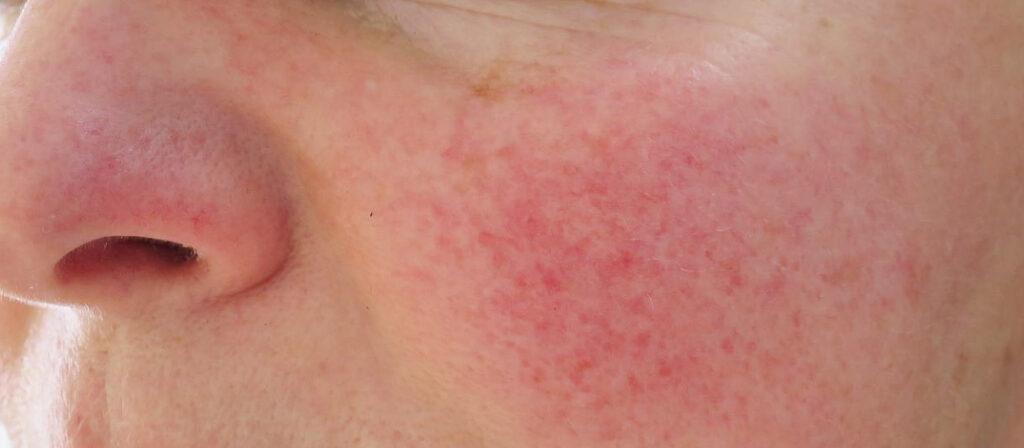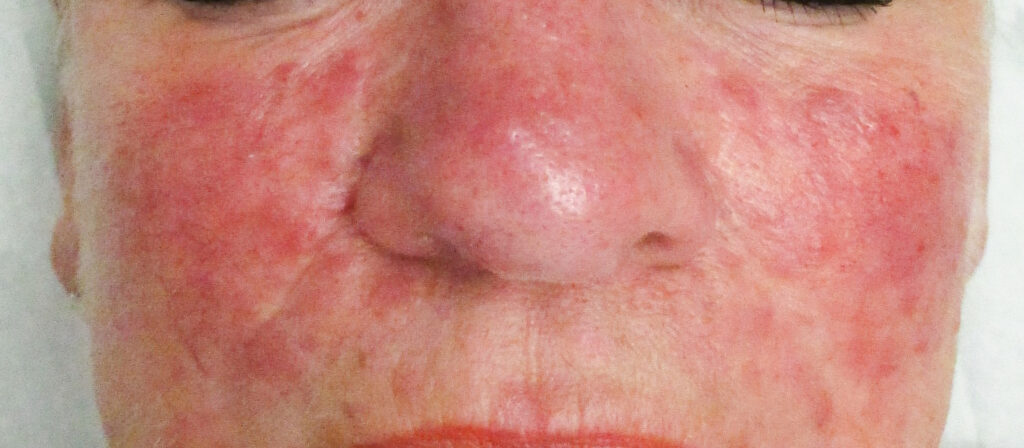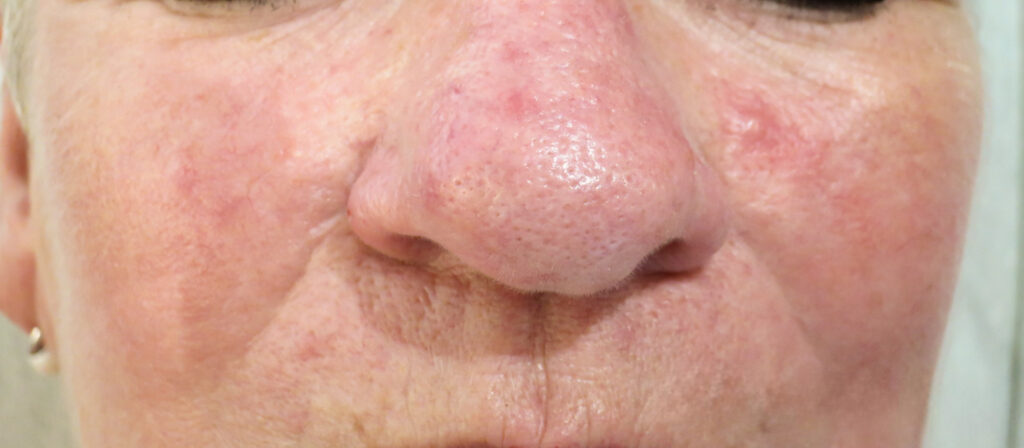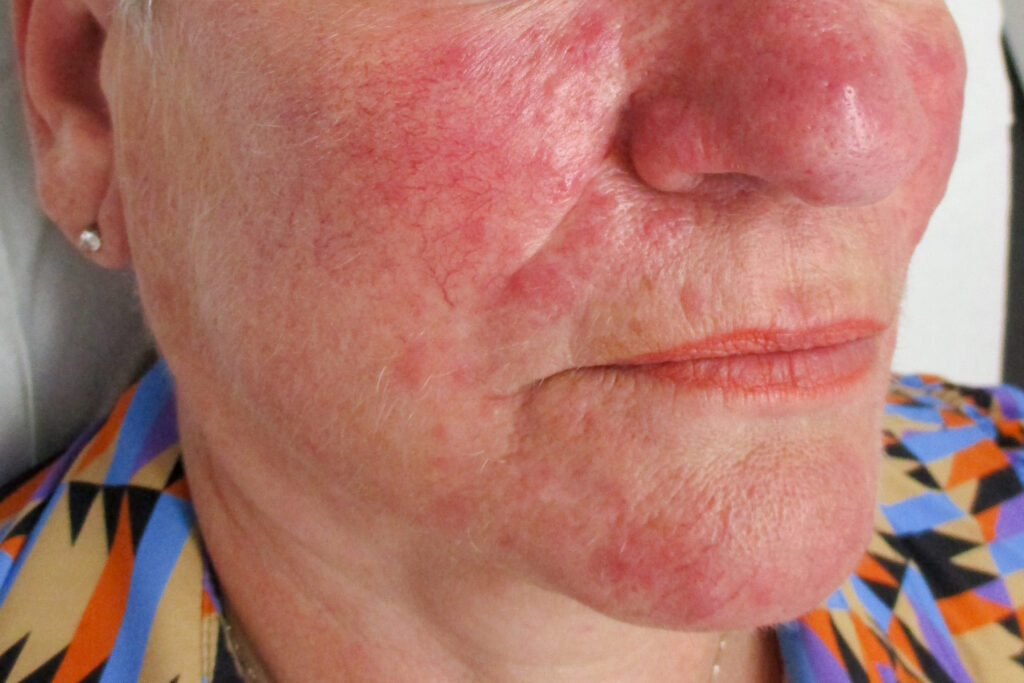Couperose & Rosacea
Red veins or spots on your skin? Fortunately, this can often be treated well with our advanced laser and IPL techniques
Redness in the face occurs in many people. Think red cheeks, a red nose or a single visible vein or spot. They are often typical examples of couperose, rosacea or skin that has seen a lot of sun. This redness can look unsightly, which can be perceived as negative.
And while these symptoms are common, few people know how relatively easy they are to treat. But how exactly does the treatment work? When can you expect results? And what should you keep in mind?
It wasn't until I'd had this treatment that I realised how calm my skin could look. Really happy with the results and the service.
Hans
Where does that redness come from?
Skin therapist Claire explains:
Red capillaries (also called teleangiectasias) occur because the walls of blood vessels weaken. As a result, the veins expand. They become wider and thicker, a phenomenon known as 'vasolidation'. They become visible in the skin as individual veins, or as a red/pink/purple glow. These veins can occur anywhere on the body, but they are most commonly seen on the face, neck or décolleté.
There are many possible causes for weakened blood vessel walls, including ageing, hormonal changes (e.g. during pregnancy), medication use, smoking, sun damage, certain skin conditions (such as rosacea) or genetic predisposition. The redness often becomes especially visible when exposed to intense heat, or during exercise. Moving from cold to warm areas, as well as consuming alcohol, hot food and hot drinks, can also dilate blood vessels and cause redness.
If the veins are on the face - especially the cheeks and nose - we call this couperose. In that case it seems as if you are always blushing.
Spider naevi are small dilated veins, usually visible as a red/purple pinhead with a number of smaller veins around it that fan out like 'spider legs'. They are therefore often called 'spiders'. Spiders can develop at a relatively young age.
Cherry angiomas are bright red benign bumps on the skin. They usually have a genetic cause and often occur later in life.
It is also possible that there is a chronic inflammation of the skin in the form of redness, bumps and pimples. This is called rosacea. Rosacea often occurs at a later age, usually after the age of thirty, and can also cause eye problems. The causes of rosacea are still unknown. It occurs more often in some families, which could mean there is a hereditary predisposition. Increased activity of the demodex mite, which lives on the skin, could also be a possible cause. In these cases, a cream prescribed by your general practitioner could help. We do know that stress, medication and weather influences such as sun and cold can worsen rosacea.
Our solution
Red skin can often be treated well with our advanced IPL and laser methods. The energy of the light (Intense Pulsed Light) and vascular lasers causes dilated blood vessels to contract (vasoconstriction) or disappear. This fades the redness that occurs, for example, in couperose rosacea or spider naevi. In some cases, inflammatory activity in rosacea also decreases, resulting in calmer skin.
In addition, the treatment stimulates collagen production, rejuvenating the skin and improving skin texture. The result is often fresher and smoother skin. The aim of each treatment is to have a positive impact on how you feel, both in your personal and professional life.
The treatment went much smoother than I had imagined. Naomi is a very attentive practitioner and really looked at what my skin needs.
Froukje

Three reasons to choose us:
The consultation
As a first step, we always want to see the skin. Every skin and every form of couperose and rosacea is different. That is why we draw up a personal treatment plan during a consultation. The exact price and the number of treatments required therefore also differ per person.
During this consultation, the laser specialist will explain how we are going to treat the redness and what the aftercare and possible complications are. They will also give advice on how to best maintain the skin, also in everyday life.
With over 30 years of experience, we have treated a wide variety of skin, couperose and rosacea.
A consultation with one of our laser specialists costs € 35,-. These costs will be deducted from the costs of the first treatment, provided the treatment takes place within 6 months of the consultation date. If you are already fairly certain that you wish to be treated, we can usually combine a consultation with an initial treatment on request.
Pre-care
It is important that the skin is as light as possible (not tanned) before treatment with the IPL and lasers.
- Avoid sun or tanning bed exposure 3 to 4 weeks before treatment.
- Self-tanning cream (bronzer) should also be avoided for 1 week before treatment.
- When using antibiotics for rosacea, the treatment cannot take place until one week after the antibiotics treatment has been completed.
- If you are pregnant or breastfeeding, you cannot be treated.
Expert, no-nonsense and service-oriented. Highly recommended!
Caroline
Treatment
Redness and irritation of the skin, such as in couperose and rosacea, are effectively treated at our clinic with the latest Ellipse IPL (Nordlys) combined with our vascular lasers (KTP laser and Nd:Yag).
The energy from the IPL and lasers causes the red veins to narrow (vasoconstriction) or even shrivel up completely. This visibly reduces redness. In addition, the light flash treatment inhibits the inflammatory reactions common in rosacea, contributing to a calmer and more even skin appearance.
With our combined methods, we not only fade redness, but also significantly improve overall skin quality
The treatment may be experienced as sensitive, depending on the area to be treated. Generally, the treatment is well tolerated by everyone and no skin anaesthesia is needed.
Treatment time varies according to the indication. A full face takes 45 minutes on average, while treating a few small veins can often be completed within 10 minutes.
A comprehensive approach
Most clinics often rely on 1 device or method to treat teleangiectasias, couperose and rosacea. We have multiple lasers and IPL methods that tackle redness in their own unique way. We therefore often use multiple laser or light flash methods per treatment. For example, we use IPL for diffuse redness, while we use vascular lasers to counteract individual veins.
The result? A customised treatment that allows us to thoroughly combat redness and improve and enhance skin quality.
Our experts
The skin is our largest organ and deserves our careful attention. We now have over 30 years of experience in treating couperose and rosacea and have therefore treated a wide variety of skin and redness. Our laser specialists are therefore extremely competent to put together and perform an effective and safe treatment.
We can effectively treat both diffuse redness and individual veins in most skin types.
How can I be sure I am in safe hands?
Laser specialist Tanja explains:
This is partly a matter of feeling, but by being critical and asking the right questions you can at least ensure that you end up with someone who is allowed to perform the treatment and who also has sufficient experience with it. Regardless of which clinic or practitioner you choose, we have put together a guide to help you with this question.
Aftercare
After treatment, it is important to follow the guidelines below for proper recovery and optimal results:
- Swelling: The next morning, there may be some swelling in the treated areas. This swelling disappears after 3-5 days.
- Sun protection: The sun and/or tanning bed should be avoided as much as possible for 3 to 4 weeks. Protect the skin with a sunscreen with SPF 30 or 50. Any self-tanning cream (bronzer) can be used again after 1 week.
- Physical exertion: Avoid activities that stimulate blood flow to the face, such as intense exercise, heavy physical activity and sauna visits. Keep this in mind in the first 4 days after treatment.
- Scabs/discolouration: Small subcutaneous brown or dark red streaks may appear. This is congealed blood in the treated veins, a normal and desirable effect of the treatment. The treated area may therefore look a little battered and unsightly, but the scabs disappear on their own after 6 to 10 days. After this, the skin will only become calmer and more beautiful.
- Camouflage: The treated areas may simply be camouflaged. We have nice products for this, which not only camouflage the skin but also help in the healing process at the same time. We also use these products in the treatment room as aftercare.
Points of attention specifically with rosacea:
- Rosacea is a chronic inflammatory condition of the skin. Sometimes a short-term flare-up may occur after treatment.
- Generally, the skin calms down after treatment and redness decreases. However, it cannot be predicted when the inflammation of rosacea will flare up again. It is well known that if the immune system is weaker, rosacea may worsen.
They were knowledgeable, and even switched with my doctors about treatment as a precaution. Very pleasant. I feel very comfortable here, and all the staff, but especially Claire, are incredibly nice.
Robin
Results
The targeted energy of IPL and vascular lasers causes the treated veins to shrink and become less visible or disappear completely. In rosacea, inflammation is also inhibited, reducing redness and giving the face a calmer appearance. This result is visible after 2 to 3 weeks.
In addition, IPL and the lasers stimulate blood flow and collagen production in the skin. This promotes skin renewal, leading to smoother, firmer skin with finer pores. The skin visibly refreshes and firms up. All this as a bonus to treating redness!
In most cases, significant improvement can be seen after only 2 treatments. Between 3 and 5 treatments may be needed, depending on the severity of the telangiectasias, couperose and/or rosacea. There should be a minimum of 4 weeks between each treatment.
If I had known how beautiful the results would be, I would have done it much earlier
Gert
Maintenance
The predisposition for teleangiectasias, couperose and rosacea remains. This means that, even after successful treatment, new veins may develop over time, making redness visible again. Sunlight (sun damage) and smoking are also known to worsen the appearance of teleangiectasias (dilated blood vessels).
In addition to the treatment, it is therefore important to care for, and protect the skin in your daily life. We recommend using a proper sun protection (SPF 30-50) at all times and to reapply it every 2 hours when you go out in the sun.
From sun and rain to scratches and aggressive make-up removers: the skin protects us every day. Not a bad idea to do something in return, right?
We have some great products with SPF that we have tested extensively ourselves, and that we also use daily in the clinic:
- Brush on Bloc is a mineral sun protection (SPF 30) in powder form and is very easy to quickly brush over the face on the go. A nice product without nasty ingredients.
- Oxygenetix is a caring and restorative foundation with SPF 30 that we have available in various skin tones. Ideal for camouflaging the skin while caring for and protecting it.
Price
A customized red vein treatment starts at € 85,-.
The exact price will be determined together with a personal treatment plan during the consultation with the practitioner.
A consultation with one of our laser specialists costs € 35,-. These costs will be deducted from the costs of the treatment, provided that the treatment takes place within 6 months of the consultation date.
Q&A
Will the redness go away forever?
Skin therapist Claire Lune explains:
With each treatment, we narrow and reduce the size of blood vessels. The predisposition for telangiectases (widening of blood vessels) remains, which can cause the skin to become redder again over time.
Rosacea is a chronic form of inflammation. This means that, while we can reduce the inflammation with every treatment, it remains unpredictable when the rosacea will flare up again and when the redness will return. For this reason, we advise to undergo a maintenance treatment every year. This way your skin remains calm and we can keep the redness under control. In the case of rosacea we also advise to visit your GP, because they can often prescribe a cream that reduces the inflammation.
If nothing is done about telangiectases or couperose, they will get worse and more severe over the years. As for rosacea, the nose can even turn purple. In that respect, these treatments can be compared to the recurring appointments with the dental hygienist: it is an appointment that is ideally repeated annually because the body continues to age and the blood vessels continue to widen.
Doesn't my body need those blood vessels?
Laser specialist Tanja explains:
telangiectases are damaged blood vessels that have lost their function. They no longer supply nutrients or remove waste products because their walls have weakened. For this reason, it can do no harm at all to treat these veins with laser and IPL. In addition, there are many more well-functioning veins that have in fact already taken over the task.
Does it hurt?
Skin therapist Claire Lune explains:
The treatment can be sensitive, depending on the area being treated. However, it is certainly not necessary to numb the skin. The treatment is generally tolerated very well by most people.
What's the price of a treatment?
Skin therapist Naomi explains:
This depends entirely on the size of the area to be treated. As an indication: our treatments start at € 85,-. for a small vein or spider nevus, while a treatment for a full face costs € 395,-.
There are many laser clinics offering this treatment. Why should I choose you?
Skin therapist Claire Lune explains:
Clinics often depend on 1 device or method with which they treat telangiectases, couperose and rosacea. We have multiple lasers and IPL methods that tackle redness in their own unique way. For example, we use the IPL for diffuse redness, while we use our vascular lasers to combat individual veins.
If one laser does not work well enough, we have ample choice to use another. This allows us to treat redness in most skin types quite effectively.
In addition, we strongly care for our customers and our aftercare is second to none. Is something wrong? Or do you still have a question? With us, your treatment does not stop as soon as you walk out the door, but you are always welcome for a check-up.
Any doubts? No problem. We are firm believers that you should look around carefully. You can use the Choice Guide we have compiled to make an informed choice wherever you go.
How do I look after treatment?
Laser specialist Tanja explains:
There may be some swelling in the treated areas for about 3 to 5 days. Usually, we also see dark red or brown lines under the skin where the blood vessels are. This is the clotted blood in the blood vessels and this is a good sign, because the laser has worked well! The treated area may look a bit battered and uneven, but the scabs will disappear by themselves after 6 to 10 days. After this, the skin will look calmer and the complexion will improve.
Can I camouflage the dark discolourations?
Skin therapist Claire Lune explains:
Yes, you can definitely camouflage the treated areas. We have beautiful products for this, which also help the skin in the healing process. You can ask about this at the counter or with your doctor.
How many treatments do I need?
Skin therapist Naomi explains:
Usually, a significant improvement can be seen after 2 treatments. Optimal results may take between 3 and 5 treatments, depending on the severity of the telangiectases, couperose and/or rosacea. There must be at least 4 weeks between each treatment.
Can you recommend a good sunscreen?
Skin therapist Claire Lune explains:
We have some great products with SPF that we have tested extensively ourselves and also use daily.
- Brush on Bloc is a mineral sun protection (SPF 30) in powder form and is very easy to quickly brush over the face on the go. A nice product without nasty ingredients.
- Oxygenetix is a nourishing and healing foundation that we have in a range of skin tones. With it, you can camouflage the skin while also protecting it with SPF 30.
What is the difference between SPF 30 and SPF 50?
Skin therapist Naomi explains:
SPF stands for Sun Protective Factor. The higher the SPF, the more protection you have from the sun's harmful UV light. In reality however, the difference between SPF 30 and SPF 50 is almost negligible. In fact, a sunscreen with SPF 30 protects your skin for about 97%, while a sunscreen with SPF 50 protects for 98%.
The main danger lies in the illusion of safety that SPF 50 brings. While it offers only 1% more protection, we are quick to think that we are 'safe' for the rest of the day with this high factor.
As such, it is much more important to reapply sunscreen every 2 hours when you go out in the sun. If you do this, it makes almost no difference whether you use SPF 30 or SPF 50!
Are there also creams against redness?
Laser specialist Tanja explains:
We have a number of gentle skincare products that will camouflage the redness and calm the skin. Please note that these products will not remove the redness - there are no products that can do that.
For this reason, these products are not intended as a replacement for a treatment, but they can certainly be a nice addition. They are well suited for people with red and sensitive skin.
- Calmwise serum
- Calmwise soothing cleanser
- Calmwise colour correct:This cream contains mineral green pigments that camouflage and neutralize redness.
During the consultation, our specialists can advise you which of our products best suit the needs of your skin.





